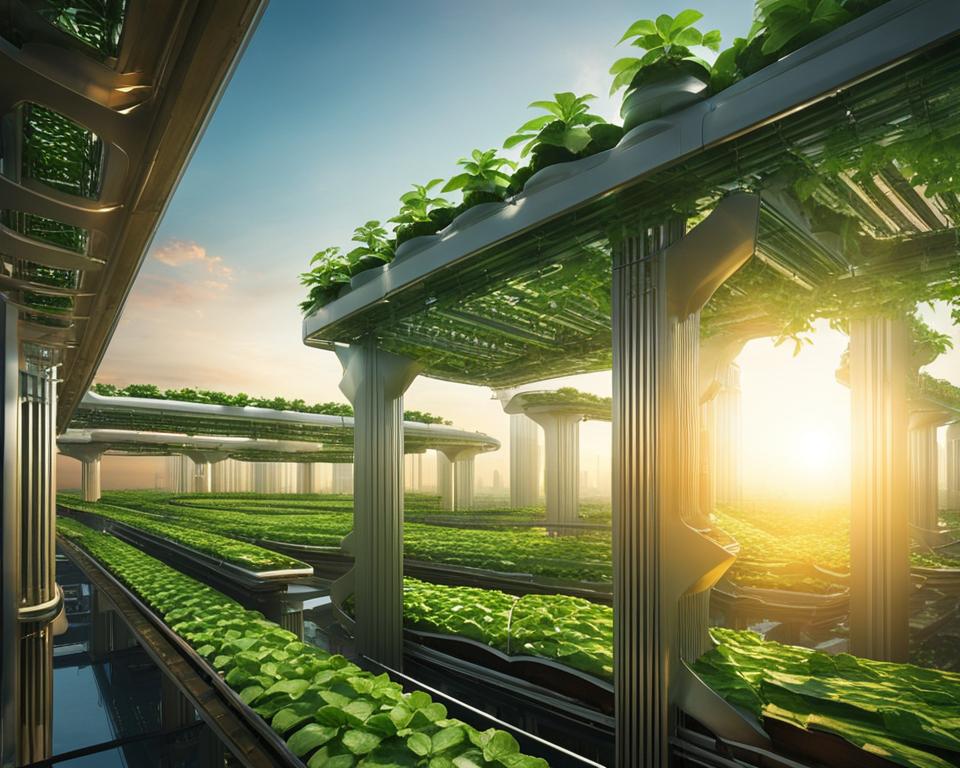Embracing innovation in agriculture, we at our publication are enamored by the transformative power of vertical hydroponic gardening systems. These advanced and sustainable methods of cultivation redefine what it means to grow fresh produce. Our cities are constantly evolving, and as space becomes an ever-precious commodity, vertical gardening systems emerge as the beacon of green revolution within our urban landscapes.
By integrating hydroponic gardening innovation into our living spaces, we are no longer limited by the constraints of traditional agriculture. These remarkable indoor hydroponic systems make it possible for enthusiasts and commercial growers alike to achieve unprecedented productivity, fostering a year-round garden that ascends not just vertically but in value and yield. Let us take you on a journey to discover how these systems not only improve the quality of our harvest but also our quality of life.
Key Takeaways
- Vertical hydroponic gardening systems lead the way in efficient, sustainable urban agriculture.
- Implementing hydroponic gardening innovations can drastically enhance crop yields and quality.
- Indoor hydroponic systems offer a resilient approach to growing produce all year round.
- Vertical gardening systems optimize space, allowing for agricultural ventures even in the smallest urban dwellings.
- Adapting to vertical hydroponics can significantly contribute to eco-friendly living and farming practices.
What is Vertical Hydroponic Gardening?
Immerse yourself in the roots of vertical hydroponic gardening, a method where nature meets innovation. This revolutionary approach to cultivation allows us to grow plants in a soilless environment by vertically stacking planters. The essence of hydroponic gardening basics lies in the unique delivery of nutrients directly through water, achieving remarkable results in plant yield and health. Vertical gardens ascend beyond traditional farming restrictions, flourishing in harmony with urban architecture.
As we dive into this futuristic form of agriculture, let us explore the core components that differentiate it from conventional gardening:
- Nutrient-rich water solution replaces soil, directly feeding plant roots
- Vertical layers of plants maximize space and create a living green wall
- Controlled environment agriculture (CEA) techniques are often incorporated
Whether you’re a city dweller with a small balcony or a commercial farmer seeking efficient land use, vertical hydroponic gardening offers a viable solution. Here’s a quick comparison to clarify how this system stands out:
| Feature | Traditional Gardening | Vertical Hydroponics |
|---|---|---|
| Space Usage | Limited to horizontal plane | Expands into vertical dimension |
| Soil Requirement | Essential | Not required |
| Water Efficiency | Less efficient irrigation | Recirculated and conserved |
| Nutrient Delivery | Dependent on soil quality | Precise and controllable |
| Yield Potential | Dependent on land area | Enhanced by vertical scaling |
In embracing vertical hydroponic gardening, our vision goes beyond mere aesthetics; it cultivates resilience and sustainability in our bustling metropolises. With vertical gardens’ ability to thrive indoors and outdoors, we are not just planting seeds, but also hope for a greener future in urban landscapes.
We envision cities where fresh produce is just an arm’s length away, where the harmony between human and plant life is not just a luxury but a standard—this is the promise of vertical hydroponic gardening.
As we continue to unveil the layers of this sophisticated farming technique, let’s ponder upon how it can elevate our living spaces and food systems. In summary, vertical hydroponic gardening transforms underutilized vertical spaces into productive and sustainable ecosystems, revolutionizing our approach to urban agriculture.
The Core Advantages of Vertical Hydroponic Systems
Within the fast-paced evolution of urban agriculture, we’re witnessing a remarkable shift towards vertical hydroponics for small spaces. This transformation is not only reshaping our approach to farming in cities but also how we view space-utilization in our daily lives. We are proud to delve into the myriad benefits these innovative systems offer, particularly for those seeking space-saving gardening solutions and hydroponic high-yield gardening.
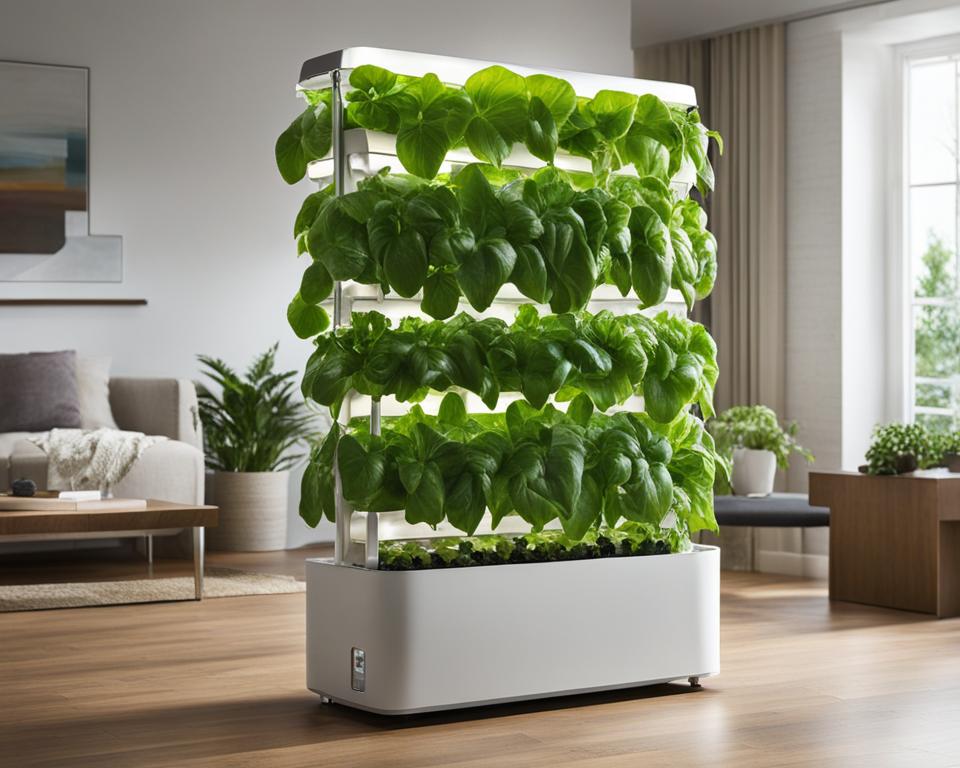
Maximizing Space in Urban Areas
For urban dwellers, maximizing harvest in confined spaces can be challenging. Vertical hydroponics, however, turns that challenge into an opportunity, effectively transforming compact areas into lush, productive gardens. Vertical hydroponic setups are the epitome of space-saving gardening—allowing crops to grow upwards rather than outwards, thus opening new horizons for urban agriculture.
Higher Yields in Smaller Footprints
With the goal of efficient planting, vertical hydroponic systems do more than save space—they drastically increase yield. A vertical hydroponic garden can produce substantially more than traditional soil-based gardens within the same footprint, thanks to its ability to stack multiple growing layers vertically. This is the true essence of hydroponic high-yield gardening: getting the most out of every square inch of your urban oasis.
- Dramatically increases plant density per square foot
- Enables continual harvest, boosting overall productivity
- Leverages vertical real estate that would otherwise go unused
Conservation of Water and Resources
When it comes to water conservation in gardening, vertical hydroponic systems set a new standard. By recirculating water, these systems use significantly less than traditional agriculture, making them key players in the pursuit of sustainable agriculture. By adopting resource-saving hydroponic methodologies, we take a step forward in preserving our planet for future generations.
| Aspect | Benefit |
|---|---|
| Water Use | Up to 90% more efficient than soil-based systems |
| Nutrient Usage | Tailored nutrient solutions reduce waste and runoff |
| Chemical Inputs | Reduced or eliminated need for pesticides |
We are at the forefront of an agricultural revolution, where vertical hydroponic systems embody the principles of sustainability and efficiency. This is not just innovation for the sake of it; it’s a practical, necessary step towards a more resource-conscious world. Vertical hydroponics for small spaces is more than a trend; it’s the future of sustainable agriculture in our cities.
Through the lens of vertical hydroponics, we see a world where every drop of water is valued, and every square inch of urban space is a potential garden — this is the power of resource-saving hydroponics.
Setting Up Your First Vertical Hydroponic Garden
If you’re thinking of starting a hydroponic garden, the concept of soilless farming might seem daunting at first. Fear not, for we’re here to guide you through the process of creating your own hydroponic garden setup. It’s easier than you might think to transform your living space with vertical gardening systems. You’ll not only grow fresh, healthy plants but also enjoy the satisfaction of tending to a garden you built with your own hands. Let’s walk through the essentials for getting your garden up and thriving.
As we embark on this journey together, remember that every big garden starts with a single plant. Your dedication to vertical hydroponic gardening can turn a small space into an oasis of greenery and abundance.
Here are the simple steps to follow when setting up your vertical hydroponic garden:
- Choose the Right Location: Look for a space with ample light—natural or artificial—and consider the proximity to power outlets and water sources.
- Select Your Vertical Gardening System: There are multiple systems to consider, from tower gardens to wall planters. Assess your space and choose a system that suits your aesthetic and functional needs.
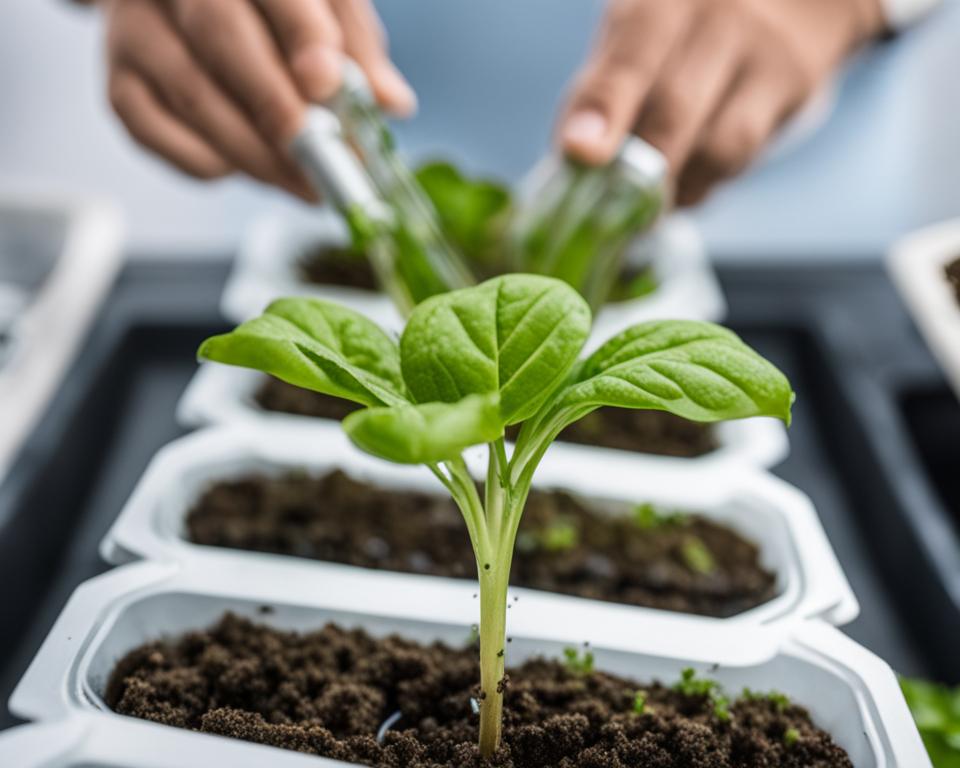
| Material/Equipment | Description | Purpose |
|---|---|---|
| Growing Towers or Trays | Stackable or wall-mounted | To hold plants in a vertical orientation |
| Hydroponic Nutrient Solution | Mineral-based plant food | To feed plants essential nutrients |
| Submersible Water Pump | For water circulation | To move nutrient solution through the system |
| Grow Lights (if indoors) | LED or fluorescent | To provide necessary light spectrum for plant growth |
| Timer | Electronic or mechanical | To automate light and water cycles |
| pH Testing Kit | Liquid or digital tester | To maintain the proper pH level of the nutrient solution |
Setting Up the System:
- Assembly: Follow the manufacturer’s instructions for your chosen vertical gardening system to assemble the structure securely.
- Preparation: Set up the water pump in the reservoir and ensure it works correctly to circulate the nutrient solution.
- Planting: Select starter plants or seeds and place them into the growing medium. Rockwool cubes or clay pellets are common choices.
- Lighting: Install grow lights as needed and connect them to the timer to simulate a natural day-night cycle for your plants.
Vertical gardening systems are a marvel of modern horticulture that allow us to grow more in less space than ever before. By following these steps, anyone can set the foundation for a thriving vertical hydroponic garden. Let this be the beginning of your fruitful journey in the world of hydroponic gardening.
Remember, the key to success with hydroponics is monitoring and adjusting. Keep an eye on the health of your plants, making sure to check the pH balance of your water and the nutrient levels on a regular basis. With a bit of care and vigilance, your vertical hydroponic garden will become a bountiful and satisfying endeavor before you know it.
Choosing the Right Crops for Vertical Hydroponics
When we venture into vertical hydroponic gardening, selecting the best crops for hydroponics is vital to the success of our garden. Not all plants thrive in a vertical hydroponic system due to various growth patterns and needs. Therefore, it’s important to focus on those suitable hydroponic plants that can flourish with limited soil and space constraints.
Leveraging our experience in the field, we’ve curated a list of plants known for their compatibility with vertical hydroponic environments. We aim to empower you with knowledge about the best plants that will ensure a thriving and productive hydroponic garden. Here are some vertical gardening tips to help you in your selection:
- Leafy Greens: Varieties such as lettuce, spinach, and kale are excellent choices due to their fast growth rates and minimal root space requirements.
- Herbs: Common herbs like basil, cilantro, and mint are ideal for vertical systems, offering a bountiful harvest of aromatic leaves.
- Strawberries: A delightful berry that adapts well to hydroponic systems, strawberries can yield fruit all year round under the right conditions.
- Tomatoes: While they require more maintenance, tomatoes can produce an abundant crop in a controlled vertical environment.
Here’s a more detailed guide to help you dive deeper into the versatility of hydroponic farming:
| Crop | Light Requirements | Growth Duration | Care Level |
|---|---|---|---|
| Leafy Greens | Moderate | 4-6 weeks | Low |
| Herbs | Moderate to High | 6-8 weeks | Low to Medium |
| Strawberries | High | 16-20 weeks | Medium |
| Tomatoes | High | 16-20 weeks | High |
With this table, you can ascertain which plants align best with your environment, resources, and the effort you’re willing to invest in managing your vertical hydroponic system. It’s all about aligning your gardening ambitions with the realities of plant care.
We must emphasize the importance of continuous learning and adaptation. As you become more seasoned in working with vertical hydroponics, you’ll discover the intricacies of each plant’s needs and develop a greener thumb along the way.
In our pursuit of bountiful harvests and lush greenery, we advise starting with a variety of species to learn what works best in your specific setup. Remember, the journey to finding the best crops for hydroponics is a process of trial and experimentation.
Lastly, don’t forget to factor in the aesthetic value of your plants. Some crops not only provide sustenance but also add a visually pleasing element to your living space. Vertical gardens are as much about beauty as they are about utility.
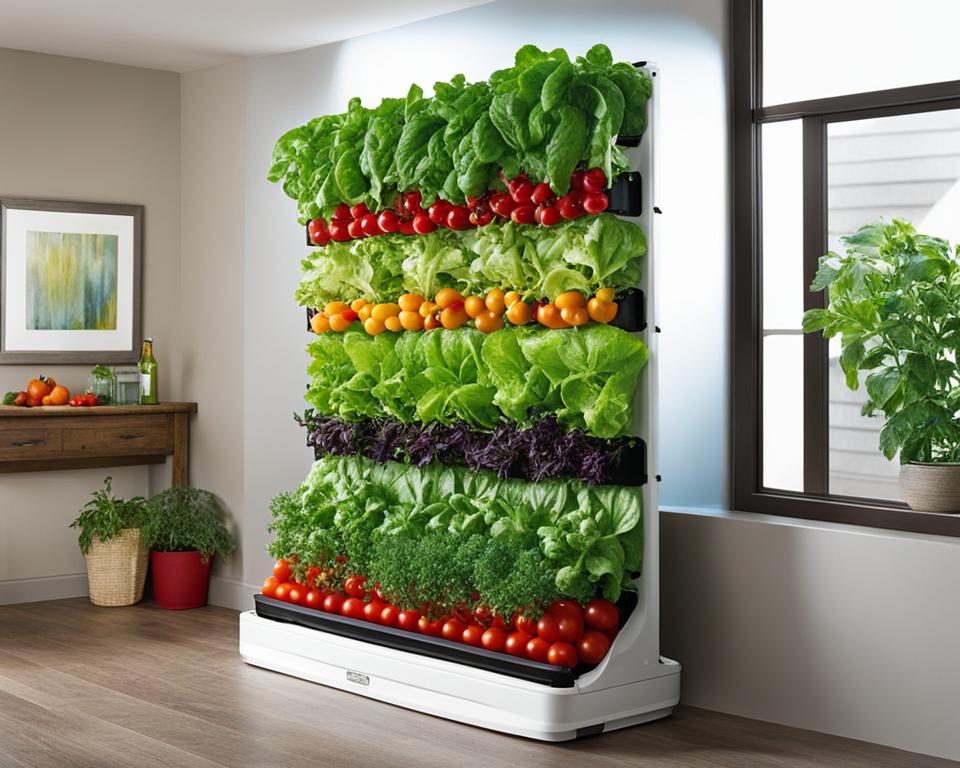
Key Components of Indoor Hydroponic Systems
Delving into the realm of indoor gardening essentials, understanding the key facets of an indoor hydroponic system is fundamental for any aspiring gardener. These systems embody a synergy of various components that facilitate plant growth without soil, offering a cleaner and more controlled environment for your greenery.
At the heart of these systems, apart from light and air, lies the imperative water circulation system; a pivotal hydroponic system component crucial for the sustenance of plant life. Let’s unfold the core components that each successful indoor hydroponic garden should include:
The Role of a Reliable Water Circulation System
Within the echelons of water circulation in hydroponics, a reliable system ensures that nutrient-rich water reaches the plant roots effectively. By constantly moving the water, it prevents stagnation, algae growth, and ensures that oxygen levels remain high enough to support root health.
Crucially, this movement mimics the natural environment where plants would typically extract their nutrients, allowing for better growth and a more robust yield. Moreover, the proper circulation system conserves water, an essential aspect of the sustainability goals of indoor gardening.
A finely tuned water circulation system is to plants what a well-balanced diet is to humans; it is vital for optimal health and growth.
Let’s look at the typical components that comprise an efficient water circulation system:
- Reservoir: Holds the nutrient solution and acts as the central hub from which water is circulated.
- Submersible Pump: Pumps the nutrient solution from the reservoir to the plants.
- Delivery Tubes: These tubes transport the water and nutrients to the grow trays or pots.
- Drainage System: Allows excess water to flow back into the reservoir, completing the circulation loop.
| Component | Function | Importance |
|---|---|---|
| Reservoir | Holds nutrient solution | Central component for nutrient management |
| Submersible Pump | Enables water movement | Essential for circulation and aeration |
| Delivery Tubes | Directs nutrients to roots | Crucial for plant nourishment |
| Drainage System | Recycles excess water | Prevents wastage and balances the ecosystem |
| Air Stones | Oxygenates water | Enhances root health and growth |
The inclusion of air stones or diffusers might also be seen as key in a water circulation setup, as they guarantee that the water remains oxygen-rich—an important aspect for healthy roots.
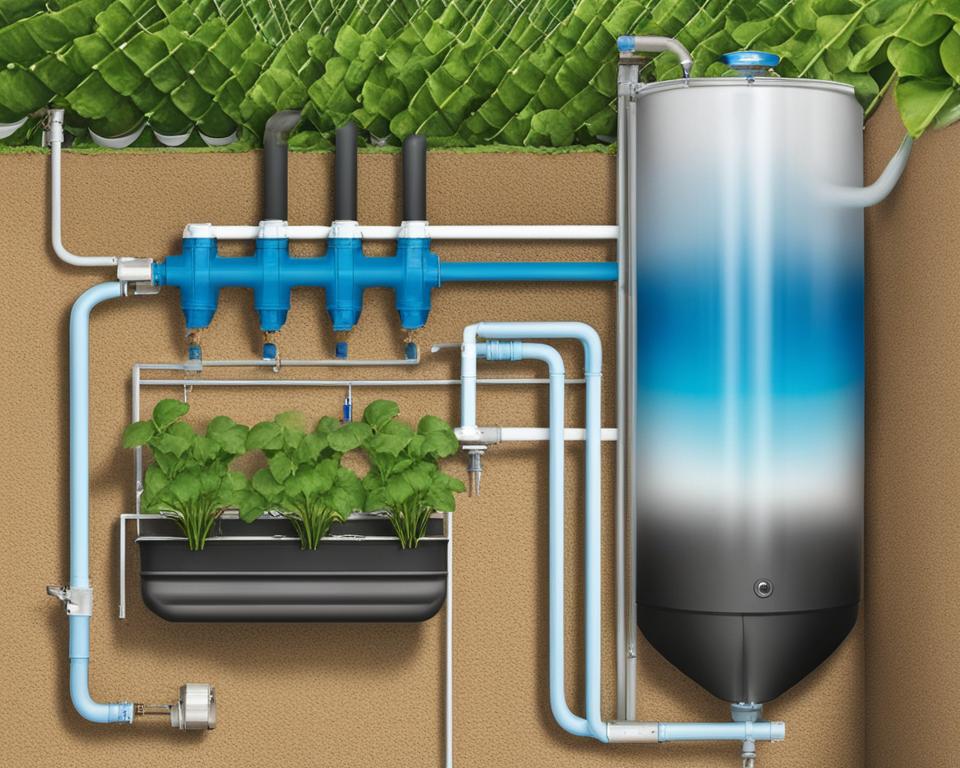
To ensure an effective water circulation system, regular maintenance checks are necessary. Keeping tubes clear of debris and ensuring the pump functions correctly are integral routines that should be established from the outset.
- Maintain cleanliness to prevent clogging and harm to plants
- Monitor water temperature to keep it within an optimal range for root health
- Check pH levels and nutrient concentrations for an environment conducive to growth
All these components come together to form a delicate balance, a micro-ecosystem that, when correctly managed, not only conserves water but also provides your plants with everything they need to grow strong and produce abundantly.
We embrace the harmonious interplay of water, nutrients, and technology as the cornerstone of successful indoor gardening—sustaining a miniature world wherein our plants can flourish.
Innovative Hydroponic Gardening Ideas and Designs
As pioneers of modern agriculture, we take pride in exploring the forefront of hydroponic gardening ideas that cater to novices and experts alike. The beauty of creative hydroponics lies in its versatility; we’ve seen an abundance of ingenious hydroponic system designs tailored to fit various spaces, purposes, and preferences. Join us as we venture through a selection of innovative ideas that could inspire your next hydroponic project.
Imagine transforming any corner of your home or business into an ecological masterpiece; that’s the power of innovative hydroponic designs.
In our commitment to inspire and educate, we’ve compiled examples of groundbreaking hydroponic setups that not only push the limits of traditional gardening but also pave the way for a future of sustainable and efficient plant cultivation:
- Modular Hydroponic Walls: These flexible hydroponic installations allow you to expand your garden as needed. The modular design facilitates easy maintenance and a customizable approach to spatial limitations.
- Automated Hydroponic Closets: Fully enclosed and automated systems that can fit in a closet space are ideal for those with limited room. These are often equipped with advanced sensors and LED grow lights for optimum growth with minimal manual intervention.
- Recycled Container Gardens: Embracing sustainability, many hydroponic enthusiasts have turned to upcycling common household items into plant containers. Old bottles, jars, and even furniture can become components of a thriving hydroponic ecosystem.
For a deeper dive into the possibilities, let’s consider some of the most captivating hydroponic system designs:
- The Aquaponic Ecosystem: An advanced system that combines the best of hydroponics with aquaculture. By integrating a fish pond into the hydroponic loop, the fish waste offers natural nutrients to the plants, while the plants help filter and clean the water for the fish.
- The Vertical Tower: Perfect for urban gardeners striving to maximize their vertical space. These towers can support a variety of plants and can be equipped with water-efficient drip irrigation systems.
To illustrate, here’s an example of a simple but effective hydroponic setup:
| Component | Description | Benefits |
|---|---|---|
| Floating Raft System | Foam rafts that float on the nutrient solution | Easy to manage and ideal for leafy greens |
| NFT (Nutrient Film Technique) Channels | Nutrient solution flows through shallow channels | Efficient nutrient delivery for a variety of crops |
| DWC (Deep Water Culture) Buckets | Plants are suspended in deep nutrient reservoirs | Allows for larger, heavier fruiting plants |
It’s essential to match the complexity of your hydroponic system to your experience level. Beginners might start with basic techniques, such as the wick system, while more experienced green thumbs might opt for the more challenging aeroponic systems.
What makes creative hydroponics so engaging is the fusion of technology, design, and nature. Each new system offers a unique opportunity to cultivate plants and ingenuity side by side. As you explore these hydroponic gardening ideas, push the boundaries of what’s possible and watch your garden—and your skills—flourish.
We invite you to step into the world of creative hydroponics where each plant you grow reflects a piece of your imagination made real through careful design and care.
Maintaining Your Vertical Hydroponic Systems for Optimal Growth
We understand the importance of hydroponic nutrient management and proper hydroponic care in maintaining hydroponics for the healthiest and most productive plants. To begin, we will delve into monitoring nutrient solutions to ensure that your garden remains a bastion of vitality and abundance.
Monitoring Nutrient Solutions for Healthy Plants
Maintaining a balanced nutrient solution is the hallmark of successful vertical hydroponics. Let’s discuss how to identify signs of nutrient deficiency or toxicity and manage your system to promote optimal plant growth:
- Regularly test pH levels to ensure they stay within the ideal range 5.5 to 6.5.
- Monitor electrical conductivity (EC) to track the nutrient concentration in your solution.
- Adjust the mix of nutrients based on the specific needs of your crops, factoring in their growth stage.
Observing your plants is your first line of defense; stunted growth, discolored leaves, or a lack of flowering can all indicate nutrient imbalances.
Here is a quick reference table to help pinpoint and solve common nutrient issues:
| Nutrient | Deficiency Sign | Excess Sign | Action to Take |
|---|---|---|---|
| Nitrogen | Yellowing of lower leaves | Dark, greasy looking leaves | Adjust the nitrogen levels accordingly |
| Phosphorus | Purple-tinged leaves | White deposits on soil surface | Regulate phosphorus content in solution |
| Potassium | Brown edges on leaves | Salt buildup | Tweak potassium concentration in feed |
| Calcium | Young leaves appear distorted or irregular | Rare but can inhibit other nutrients | Ensure proper calcium balance |
| Magnesium | Leaves with yellow patches between veins | Can cause leaf curl | Maintain magnesium level in line with plant requirements |
Maintaining this balance of nutrients is essential for optimally healthy hydroponic plants, as each element plays a critical role in plant development and fruit production.
Controlling the Climate and Lighting Conditions
In the realm of hydroponic care, mastery over your indoor environment is key to sustaining growth and productivity. Let’s turn our focus toward creating ideal gardening conditions specific to vertical hydroponic systems:
- Maintain a constant temperature to promote growth, generally between 65-75°F (18-24°C).
- Install grow lights for hydroponics to ensure plants receive the necessary light spectrum
- Use timers to simulate natural daylight cycles, typically between 14-16 hours of light per day.
- Consider hydroponic climate control systems to regulate humidity, typically aiming for 40-60%.
Remember, the climate encompasses temperature, humidity, and air circulation, all of which must be finely tuned to mimic the great outdoors.
Each plant species has particular climate preferences; therefore, it helps to chart out the needs of your selected plants in regards to hydroponic climate control:
| Plant Type | Ideal Temperature | Ideal Humidity | Lighting Needs |
|---|---|---|---|
| Leafy Greens | 60-70°F (15-21°C) | 45-55% | Medium light intensity |
| Herbs | 65-70°F (18-21°C) | 40-50% | High light intensity |
| Fruiting Vegetables | 70-75°F (21-24°C) | 50-60% | High light intensity |
| Orchids | 65-80°F (18-27°C) | 40-70% | Low to medium light intensity |
By thoughtfully managing these aspects, your vertical hydroponic system will support a diverse array of plant life each experiencing its own optimal conditions for robust growth.
DIY Hydroponic Systems vs. Commercial Solutions
As we navigate the landscape of modern hydroponics, we often encounter a pivotal choice: constructing DIY hydroponic systems or opting for commercial hydroponics. Both paths offer unique hydroponic gardening benefits, but the decision hinges on individual goals, budget, and commitment to the craft of gardening. Let’s delve into the advantages and limitations of each approach to guide you toward making an informed decision.
Whether you’re a hands-on tinkerer or a busy professional seeking efficiency, there’s a hydroponic solution tailored to your lifestyle and aspirations.
Pros and Cons of DIY Hydroponic Systems
DIY enthusiasts often revel in the challenge and satisfaction that comes from building a system from the ground up. The flexibility to customize and tweak your setup is a significant draw. However, it’s important to consider the time and effort you’re willing to invest. Here’s what to weigh:
- Pros:
- Customization to fit specific spaces and plant types
- Educational experience that enhances understanding of hydroponics
- Often more cost-effective initially than commercial options
- Cons:
- Time-consuming setup and potential for errors
- Requires deeper understanding of system components and plant needs
- May lack the advanced features of commercial systems
For those who enjoy DIY projects, the journey of building your hydroponic system can be as rewarding as the lush greens it yields. Yet, it’s essential to recognize it’s not just a weekend hobby; it’s a commitment to ongoing learning and troubleshooting.
Pros and Cons of Commercial Hydroponic Solutions
In contrast, commercial hydroponic systems provide a streamlined entry into the world of hydroponics. These pre-designed systems come with everything you need to get started, along with support and warranties. Let’s compare:
- Pros:
- Plug-and-play convenience with less assembly required
- Often come with customer support and guidance
- Include built-in technologies for monitoring and adjusting conditions
- Cons:
- Higher upfront cost compared to DIY systems
- Less room for customization to individual preferences
- Might include features you don’t need, adding unnecessary complexity
The efficiency and relative ease of a commercial system could be the deciding factor for urban gardeners or those less inclined towards hands-on maintenance. These systems can offer an excellent balance between convenience and advanced hydroponic capabilities.
Decision Factors: Choosing the Path That Suits Your Needs
Ultimately, the choice between DIY and commercial comes down to personal considerations. Reflect on the following aspects:
| Factor | DIY Hydroponic Systems | Commercial Hydroponics |
|---|---|---|
| Budget | Lower initial investment, potential higher long-term costs | Higher initial cost, but potentially lower maintenance expenses |
| Time Commitment | High – planning, building, and continuous learning | Low to Moderate – setup and follow pre-defined maintenance |
| Customization | High – tailor to specific plants and spaces | Low to Moderate – dependent on the product range |
| Support/System Reliability | Self-reliant – reliant on personal knowledge and forums | Manufacturer support – often includes warranties and help desks |
Each system has its unique hydroponic gardening benefits, and no single option is universally better. Whether you decide to embark on a DIY project or opt for a commercial hydroponic system will depend on your enthusiasm for building, the time you can dedicate to maintenance, and the level of customization you require for your gardening goals.
We encourage you to weigh the pros and cons carefully, recognizing that the journey into hydroponics is as much about growing plants as it is about growing your own skills and understanding of this fascinating way to garden.
Conclusion
As we draw our exploration of vertical hydroponic gardening systems to a close, we reflect on the profound benefits this innovative agricultural method offers. Not only does it equip us with practical hydroponic gardening tips to optimize our urban spaces, but it also introduces us to the significant environmental advantages these systems provide. Advancements in vertical hydroponics enable us to embrace a future where fresh, nutritious produce can be cultivated right in our backyards or even inside our homes, irrespective of the changing seasons or urban confines.
Understanding the benefits of vertical hydroponic gardening sheds light on the importance of this practice in modern urban living. Not only does it allow for water conservation and increased crop yields, it also contributes to a sustainable lifestyle by reducing food miles and the need for harmful pesticides. Our journey through the tiers of vertical hydroponics emphasizes how these systems herald a greener, more self-sufficient future, grounded in ecological consciousness and innovation.
Together, we’ve traversed the world of vertical hydroponics, equipped with an arsenal of insights and encouragements. Now, with a wealth of knowledge at our fingertips, we stand poised to take control of our food sources and contribute positively to our planet’s well-being. Let us harness the benefits of vertical hydroponic gardening and turn the page to a new chapter of agricultural self-reliance and environmental stewardship.
FAQ
What is Vertical Hydroponic Gardening?
Vertical hydroponic gardening is a method of growing plants without soil by stacking planters vertically and delivering nutrients directly through water. This innovative approach maximizes space and can be implemented indoors or outdoors, offering a sustainable option for urban gardeners and commercial producers alike.
How can vertical hydroponic systems benefit urban growers?
Urban growers benefit greatly from vertical hydroponic systems as they make efficient use of limited space. These systems allow for high-density planting, turning small areas into productive gardens. They can also contribute to improved air quality and the reduction of urban heat islands by introducing more greenery into concrete-dense environments.
What are the environmental benefits of hydroponic gardening?
Hydroponic gardening provides numerous environmental benefits, including significant water conservation compared to traditional soil-based methods. Hydroponics uses a closed-loop system that recirculates water and nutrients, resulting in less waste. Additionally, it reduces the need for pesticides and herbicides, minimizes soil erosion, and due to its controlled nature, can prevent nutrient runoff into natural waterways.
What do I need to set up a basic vertical hydroponic garden?
To set up a basic vertical hydroponic garden, you’ll need vertical gardening systems or planters, a water circulation system, nutrient solutions, grow lights (if indoors), seeds or plantlets, and a bit of patience. Depending on the complexity of the system, you may also require a pump, timer, and pH testing kit to ensure optimal growth conditions.
Which crops are best suited for vertical hydroponic systems?
Leafy greens like lettuce, spinach, and herbs are particularly well-suited for vertical hydroponic systems due to their relatively small root systems and quick harvest times. Other plants that thrive in vertical hydroponics include strawberries, bell peppers, and certain varieties of dwarf tomatoes and cucumbers.
Why is water circulation important in hydroponic systems?
In hydroponic systems, water circulation is crucial as it ensures that the nutrient solution is evenly distributed amongst the plants. It also keeps the water oxygenated, which is vital for healthy root development and disease prevention. Proper circulation helps prevent stagnation, minimizes the growth of algae, and maintains a balanced ecosystem for the plants.
Can I create my own hydroponic gardening system at home?
Absolutely! Many gardeners enjoy building DIY hydroponic systems using materials like PVC pipes, buckets, and household containers. With the right instructions and some creativity, you can tailor a system to fit your specific space and needs. Of course, it’s important to research thoroughly and understand the principles of hydroponics before you start.
Are commercial hydroponic systems better than DIY ones?
Whether commercial hydroponic systems are better than DIY ones depends on your individual goals, resources, and level of expertise. Commercial systems often offer greater sophistication, automation, and consistent yields, which can be ideal for commercial growers. However, DIY systems can be more cost-effective and offer more customization, which is great for hobbyists and those wanting to experiment or learn more about the process.
What are some innovative hydroponic garden designs?
Innovative hydroponic garden designs range from simple, homemade vertical towers and wall gardens to more advanced automated systems featuring AI technology for monitoring plant health. Other creative designs include modular setups that can be expanded over time, rotating gardens that ensure even light distribution, and aesthetically pleasing living walls that serve as both decoration and food source.
How do I maintain optimal growth conditions in my hydroponic garden?
Maintaining optimal growth conditions in your hydroponic garden involves regularly checking and adjusting the nutrient solutions, ensuring proper lighting and temperature control, monitoring pH levels, and keeping an eye on plant health for any signs of distress. Automated systems can help keep these variables in check, but attentive care and observation are always key.

